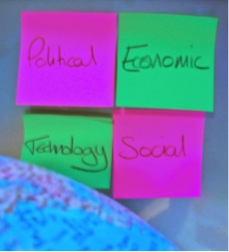Two planning tools to help make your business an export success story
Two planning tools to help make your business an export success story
- Export success boosts small business profits by as much as £100K a year.
- Six in 10 small businesses will be exporting by 2016.
- 85% of businesses surveyed told UKTI that exporting led to levels of growth ‘not otherwise possible’.

These big numbers are helping build confidence in the small and medium-sized business community that exporting is a worthwhile way of growing turnover and profits. Export success story case studies are encouraging too.
- In just five years, The Cambridge Satchel Company
 graduated from kitchen tabletop, to iconic accessory in 110 countries, clearing £5 million in export earnings alone.
graduated from kitchen tabletop, to iconic accessory in 110 countries, clearing £5 million in export earnings alone. - Bike infrastructure innovators Cyclehoop
 are now on the streets in 15 European countries, New Zealand, Canada and Japan.
are now on the streets in 15 European countries, New Zealand, Canada and Japan. - Six-year-old Tangle Teezer
 hairbrushes are sold online into the 290 million Chinese consumer market from just one UK-based desk.
hairbrushes are sold online into the 290 million Chinese consumer market from just one UK-based desk.
Growing your business to an export success story
To see your business featured in the list of export success stories, you need to be confident that your products, your services and your marketing strategy will deliver real returns in a reasonable timeframe. And of course, when you’re doing it all on a very tight budget, it’s even more of a challenge to know where to best invest time and money. These two classic management tools will help make your business an export success story. They’re all about diving deep into your target markets before you actually put a toe in the water!
1 PEST is best
Everyone knows about SWOT analysis: taking an in-depth look at your
Strengths/ Weaknesses/Opportunities/Threats
If you’re looking to export successfully, a PEST brainstorm of your target overseas markets us a must. Set up a grid, just as you do for a SWOT, but this time, do your research on your target markets focusing on:
P for Political situation
E = Economic
S= Social factors
T = Technology.
Exporters can usefully turn a PEST into a PESTLE by adding in Legal and Environmental to the matrix.
You may feel you’ve thrown up more questions than answers. And that’s the point. It’s researching the answers that make a PESTLE well worth the time and effort.
2 Six Hats for success
Edward de Bono’s classic Six Hats exercise is really several tools in one.
- Helping you develop new products or services
- Warning of bear traps and banana skins
- And once you’ve looked at what you do from the viewpoint of all six hats, you’ll have a robust Plan B for when it rains on your parade
Six Hats works like this: get your team together and view your export plans through the perspective of each of the six hat personas in turn.
- White hat: Put your logical head on. Look at current and historical data. Drill down. Fill gaps.
- Red hat: All about gut feeling and intuition. Look beyond your own feelings. What sort of emotions will you provoke in customers and employees?
- Black hat: There’s a place for negativity, caution and being risk-averse. And this is it, so seek out problems and barriers. How will you get round them?
- Yellow hat: Sunny-side up with rose-tinted glasses, for the best of outcomes in the best of all possible worlds. What do you have to do to make it happen?
- Green hat: Release your creative side. Dream a little. Shoot for the moon. Change products and processes for the better.
- Blue hat: Just like the UN peacekeepers in their blue berets, look for constructive ways to channel your team’s energies and enthusiasms, doubts and concerns.
Seasoned marketers and exporters often run a second Six Hats exercise. Try a new set of hats to put yourself directly in your customers’ shoes.
- Try white and red for different socio-economic groups.
- Black and Yellow for contrasting generations.
- Go green for your existing English-speaking customers.
- Blue is for analyzing what you offer all your new customers who speak the language of your target export markets.
Although English is seen as the international business language, only 25% of online searches are done in English. And, people everywhere like to buy from companies they know and trust – so it makes good business sense to talk to customers in their own language.
Our Go Global packages offer cost-effective translations that over come language barriers, helping you communicate quickly, expertly and reliably with your overseas customers.
Go Global Starter Pack – http://www.cintra.org.uk/our-services/translation-for-exporters-go-global/go-global-starter-pack 
Go Global Advanced – http://www.cintra.org.uk/our-services/translation-for-exporters-go-global/go-global-advanced 






Leave a Reply
You must be logged in to post a comment.